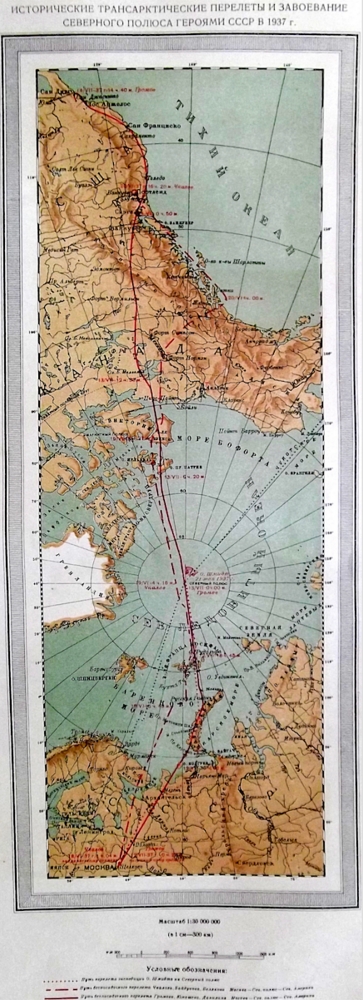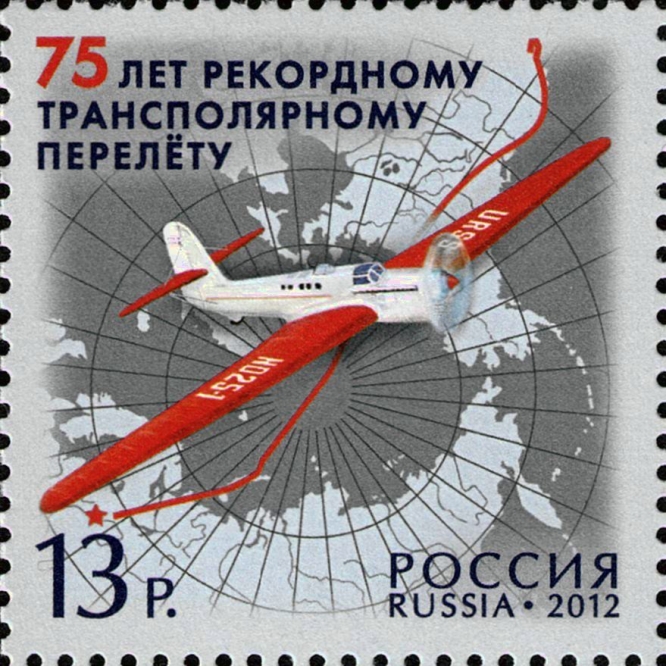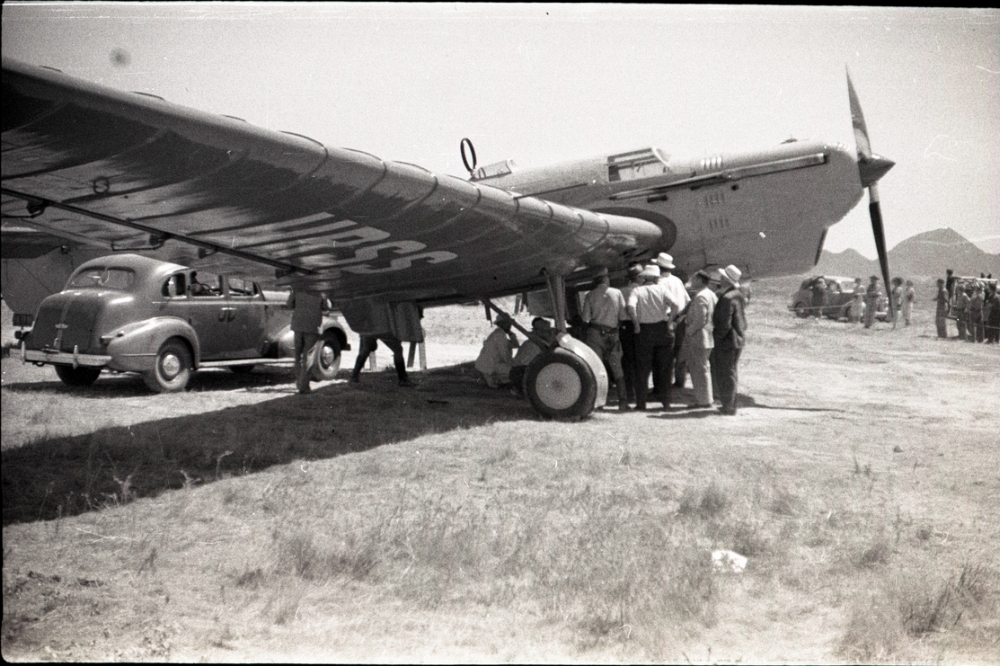The Tupolev ANT-25 was a Soviet long-range experimental aircraft which was also tried as a bomber. First constructed in 1933, it was used by the Soviet Union for a number of record-breaking flights.The ANT-25 was a single-engine low-wing monoplane, primarily of metal construction, with retractable landing gear. The wings and horizontal stabilizer were covered with corrugated sheet metal. The troughs were filled with balsa wood to create a smoother surface. It was flown by a crew of three. The pilot was placed directly behind the engine, followed by a crew rest area, then the navigator/radio operator’s station. The copilot flew the airplane from a small enclosed cockpit behind the navigator’s station.
Development
The ANT-25 was designed as the result of a recommendation by Kliment Voroshilov to the Revolutionary Military Council Revvoyensovyet on 7 December 1931, to build an aircraft for long-range flights.
The aircraft was designed by the brigade of the Experimental Aircraft Design Department of TsAGI led by Pavel Sukhoi under the overall supervision of Andrei Tupolev. The first prototype, designated Experimental Airplane RD-1, (also designated TsAGI-25, ANT-25), RD standing for Rekord Dalnosty, i.e. “Range Record”) made its maiden flight on 22 June 1933, piloted by Mikhail Gromov, using a direct-drive M-34 engine.
The first crew, Gromov, Filin and Spirin, began with a long-range test flight in September 1934 on the second prototype, the RD-2. The RD-2 used a geared M-34R engine, which substantially increased its range. They spent 75 hours in the air, covering 12,411 kilometres (7,712 mi) in a single trip, (Moscow–Ryazan–Tula–Dnepropetrovsk–Kharkov). The aircraft was unable to return to Moscow because of a fuel shortage. Gromov was made a Hero of the Soviet Union. The flight was not recognised as a world record as it could not complete the circuit to Moscow, and so could not claim the closed-circuit record, while the direct distance between Moscow and Kharkov was too short for the distance in a straight-line record.
Gromov and Andrey Yumashev decided to make their next long-range flight an attempt at the straight-line record. They wanted to fly the traditional long-range route via Africa and the Atlantic Ocean to South America. A crewman, Sigizmund Levanevsky, on studying some maps, suggested they fly in a completely different direction – to the north. Polar aviators were extremely popular at that time, so his plan was considered plausible. The flight was cancelled in the spring of 1935 when he fell seriously ill.
The next long-range flight planned was from Moscow to the US via the North Pole. A sloping concrete runway, 4 kilometres (2.5 mi) in length, was built at Schelkovo air base near Moscow. In the early morning of 3 August 1935, Levanevsky, Baydukov and Levchenko climbed aboard their RD and took to the air. For the first 50 kilometres (31 mi), the aircraft ascended to only 500 metres (1,600 ft). They then steadily increased their altitude to 5,000 metres (16,000 ft), maintaining an average speed of 165 kilometres per hour (103 mph). After approximately 2,000 kilometres (1,200 mi), an oil leak was discovered, but the aircraft was able to make an emergency landing at Krechevits near Novgorod. Levanevsky was called to a Politburo meeting, where he blamed Tupolev, declaring that his single-engined ANT-25 was underpowered. It seemed to be the end for the aircraft.
His second pilot, Georgy Baydukov, who was also an aviation engineer, disagreed and proposed Valery Chkalov for a second attempt. Chkalov was at first sceptical about his selection, as he was a fighter pilot with little navigational knowledge. Baydukov briefed Chkalov on the finer points of flying the ANT-25 and proposed Alexander Belyakov, who was the chief instructor of their flight academy, as their third crewman. Chkalov’s authority was enough to convince Joseph Stalin.
In July 1936, the record was broken by Chkalov, Georgy Baydukov and Belyakov flying the same aircraft from Moscow to the Far East (Stalin’s Route) in 56 hours 20 minutes, a distance of 9,374 kilometres (5,825 mi). They passed Franz Josef Land–Severnaya Zemlya–Tiksi–Yakutia–Petropavlovsk-Kamchatsky–Khabarovsk–Okhotsk Sea and landed on a beach at Udd Island (now called Chkalov Island), near the Amur River.
The next day, the Pravda newspaper published a leading article “Glory to Stalin’s Falcons!” («Слава сталинским соколам!»).[2] A wooden runway was constructed on Udd island, and on 2 August the ANT-25 departed for Moscow. The trip back lasted a week, with stops at Khabarovsk, Chita, Krasnoyarsk and Omsk, with a grand welcome at each. Chkalov’s trio each became a Heroes of the Soviet Union. Two islands nearby were renamed after Baydukov and Belyakov.
Chkalov’s achievement became world-famous; however, the Politburo still wanted the publicity of a direct flight. Gromov was ordered to fly to Brazil on 14 August 1936 in a second ANT-25, but as he prepared for the start on 25 September, Brazilian officials denied access to the Soviet plane, and the flight was cancelled.
Both Chkalov’s and Gromov’s crews were now destined to fly north from Moscow to San Francisco. Over 18–20 June 1937 – the same crew of pilot Valery Chkalov, co-pilot Georgi Baidukov and navigator Alexander Belyakov made a non-stop flight from Moscow to Portland, United States, in bad weather. At the 60-hour point they passed Seattle, and after two more hours they passed the Portland lighthouse on the Columbia River and headed deeper into US territory.
Over the city of Eugene they found they were short of fuel and turned back for the army airbase at Fort Vancouver Barracks at Vancouver, landing at Pearson Airfield. The 9,130-kilometre (5,670 mi) trip took 63 hours and 25 minutes. In 1975, an obelisk was erected on the airfield to commemorate this event.
Sources: YouTube; Wikipedia; This Day in Aviation History




